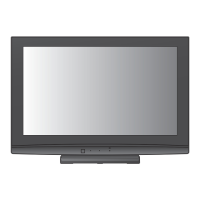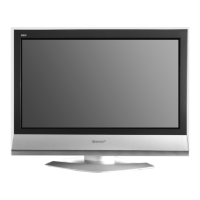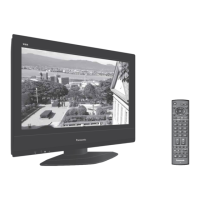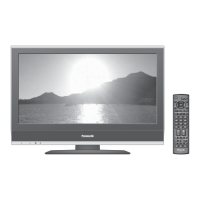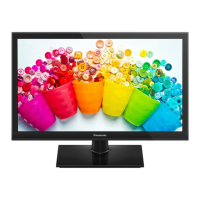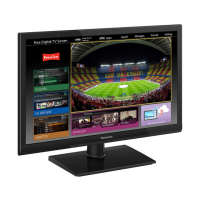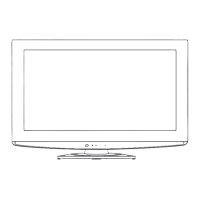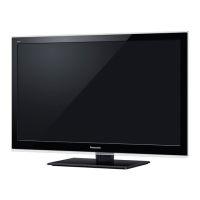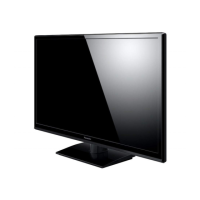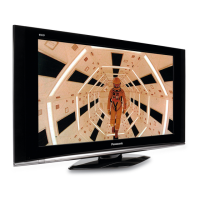Do you have a question about the Panasonic Viera TX-26LXD80 and is the answer not in the manual?
Information about the transition to digital TV services in the UK and required actions.
Instructions for safe handling and connection of the power cord to the TV.
Specifies the TV's voltage and frequency requirements for operation.
Warns against accessing internal parts due to electrical hazards.
Advises against exposing the TV to direct sunlight or heat sources.
Caution regarding excessive headphone volume causing irreversible damage.
Warning against placing the TV on unstable or sloped surfaces.
Detailed safety information and instructions for replacing the fuse in the mains plug.
Prevents damage and electric shock by avoiding exposure to moisture.
Emphasizes not blocking rear ventilation openings for proper heat dissipation.
Advises on maintaining space around the TV for radiated heat.
Stresses using dedicated pedestals/mounts for stability and safety.
Warns about the danger of children swallowing SD cards.
Explains the TV's automatic standby mode when no signal is received.
Advises keeping the TV away from certain electronic equipment and infrared sensors.
Guide on gentle cleaning methods for the display panel to avoid damage.
Instructions for cleaning the TV's cabinet and pedestal.
Recommends regular cleaning of the mains plug to prevent fire hazards.
Lists the items included with the TV, like remote and batteries.
Step-by-step guide for inserting batteries into the remote control.
Instructions for using the clamper to manage cables.
Information on available optional accessories like wall-hanging brackets.
Instructions on how to safely remove the TV's pedestal.
Identifies key controls on the TV and its remote for operation.
Illustrates connecting an aerial to the TV for reception.
Shows how to connect a DVD recorder or VCR to the TV.
Illustrates connections for DVD recorders, VCRs, and satellite receivers.
Guides on plugging in the TV and starting the initial setup process.
Explains how to input the Owner ID during the initial setup.
Prompts the user to select their preferred picture environment setting.
Explains how to use the remote control for menu navigation and adjustments.
Describes the on-screen help feature for guidance.
Instructions on how to turn the TV on using the power switch.
Guide on switching between digital (DVB) and analogue TV modes.
How to choose a TV channel using number buttons or program up/down.
Function to freeze or unfreeze the displayed TV picture.
How to show or hide subtitles for programmes.
How to view programme information such as title, time, and available features.
Shows how to adjust settings like Multi Audio and Subtitle Language.
Allows instant viewing of programme status and selectable settings.
Setting a timer to automatically turn the TV off after a specified period.
Guide on changing the picture's aspect ratio for optimal viewing.
Explains the nature of DVB teletext services compared to analogue.
How to switch to DVB mode if currently in analogue.
Steps to activate the teletext service using the remote.
Information on using remote control buttons to navigate teletext pages.
Explains the differences and usage of FASTEXT and List modes for teletext.
How to switch between teletext modes via the Setup menu.
Guide on how to select specific teletext pages using number buttons.
Function to reveal hidden words or answers in teletext.
Freezes the current teletext page to prevent automatic updates.
Navigates back to the main teletext index page.
Option to display subtitles for programmes.
Watch TV and Teletext simultaneously in a split screen.
How to save favorite teletext pages for quick access.
Accessing multiple sub-pages within a teletext service.
Allows viewing TV content while teletext information is being downloaded.
How to switch between landscape and portrait views of the TV guide.
Options to adjust the TV Guide display layout for better readability.
Moving between days to view upcoming programme listings.
Filtering programme listings by type or category.
Choosing a programme directly from the TV Guide for viewing or recording.
Accessing detailed information about a specific programme event.
Setting up a timer recording for an event on an external device.
How event recording works based on TV Guide information.
Accessing and updating advertisement information for the TV Guide system.
Instructions for powering on the TV and connecting external equipment.
How the TV automatically switches input when external devices are activated.
Accessing the menu to choose the input source for external devices.
Guide on selecting the desired input terminal for connected equipment.
Table detailing terminal connections and their functions.
How to control VCR, DVD, and other Panasonic devices with the TV remote.
Setting the remote to control either a VCR or a DVD player.
Covers common operations like Standby, Play, Stop, Rewind, Fast-forward, Pause, Record.
Steps to access the TV's main menu system.
How to navigate and select main menu categories like Picture, Sound, Setup.
Choosing specific settings or functions within a selected menu.
Making adjustments or selections for menu items using the remote.
Selecting options from lists or alternative settings.
Using slide bars to adjust settings like Sharpness or Colour.
Moving to subsequent screens or sub-menus within the settings.
Inputting text for user-defined fields like names or passwords.
Navigating through multiple pages of menu options.
Options to reset picture, sound, or all TV settings to default.
Lists and explains functions related to VIERA Link control of connected equipment.
Details various picture settings like Viewing Mode, Contrast, Colour, and Noise Reduction.
Explains sound settings including Mode, Bass, Treble, Surround, and Audio Description.
Lists setup options such as Timer Programming, Child Lock, Auto Setup, and System Update.
Configuration options for the TV Guide and advertisement display system.
How to switch to DVB mode if currently in analogue.
Steps to access the main menu to configure DVB settings.
Navigating to the Setup menu to access advanced DVB options.
Accessing settings for Pay-TV modules and software updates.
Final step to apply the selected DVB settings.
Instructions for inserting and accessing CI modules for Pay-TV services.
Guide on downloading and installing new software for the TV.
Choosing the mode for programme list management.
Accessing the setup menu to find programme editing options.
Guide to DVB Profile Edit, Service List, or Child Lock functions.
How to create and manage personal programme lists (Profiles).
Hiding unwanted channels from the channel list.
Renaming or reordering analogue channels.
Locking specific programmes or inputs using a PIN.
Choosing the reception mode for programme tuning.
Accessing the setup menu to find tuning options.
Navigating to the Tuning Menu within the setup options.
Choosing specific tuning functions like Auto Setup or Manual Tuning.
Final step to apply the selected tuning preferences.
Automatically scans and stores all available programmes.
Manually tuning DVB programmes by frequency and signal strength.
Manually tuning analogue programmes by channel position.
Scanning for and adding newly available DVB services.
Setting up notifications for new DVB services found.
Verifying the quality and strength of the DVB signal.
Accessing the main menu to initiate settings restoration.
Navigating to the Setup menu for system-wide resets.
Choosing the option to reset all TV settings to factory defaults.
Confirming the reset operation and following on-screen instructions.
Accessing the main menu to configure owner information.
Navigating to the Setup menu to find the Owner ID option.
Accessing the Owner ID settings screen.
Entering a 4-digit PIN for identification and security purposes.
Inputting name, address, and postcode for owner identification.
Procedure for modifying the existing PIN number.
Accessing the main menu to manage input labels.
Navigating to the Setup menu to find input label settings.
Accessing the screen for naming or skipping input terminals.
Customizing names for input terminals or skipping unused ones.
Using the on-screen keyboard to input custom names for inputs.
Choosing the correct input source to display the PC screen.
Specific steps to select the PC input from the input menu.
Adjusting picture and setup settings for optimal PC display.
Setting up programmes to record automatically via the menu.
Accessing the main menu to initiate recording functions.
Navigating to the Setup menu to access timer programming.
Accessing the timer programming screen for setting recordings.
Configuring recording times and storing them.
Fine-tuning timer recording parameters like date, time, and repetition.
Instructions for properly inserting an SD card into the TV.
Accessing the mode to view photos stored on the SD card.
Browsing and selecting photos displayed as thumbnails.
Organizing and viewing photos based on their recording date.
Displaying photos one at a time with navigation options.
Starting and controlling an automatic slide show of photos.
Adjusting the interval and repeat options for slide shows.
Compares the features and connectivity of Q-Link and VIERA Link.
Details the necessary cables and terminal connections for linking devices.
Specifics on connecting DVD recorders/VCRs using SCART for Q-Link.
How to connect devices using HDMI and SCART for VIERA Link.
Connecting amplifiers or player theatres for speaker control via Link functions.
Steps required for Q-Link setup and its available features.
How to record programmes directly from the TV using a connected recorder.
How recording status and messages are displayed.
Automatic TV power-on when connected equipment is activated.
Automatic standby of connected equipment when the TV is set to standby.
Explains VIERA Link's advanced HDMI control capabilities.
Steps needed to set up VIERA Link connectivity.
Overview of features like Easy playback, Power on/off link for VIERA Link.
Recording programmes directly using VIERA Link with DIGA recorders.
Pausing live TV and resuming later using VIERA Link with DIGA recorders.
Using the TV remote to control menus of linked equipment.
How to operate equipment with HDAVI Control function.
Handling equipment not compatible with HDAVI Control.
Controlling theatre speaker volume and selection using the TV remote.
Options to select between TV speakers or home cinema speakers.
Diagrams for connecting camcorders and game consoles.
Illustrates connecting camcorders via HDMI.
How to connect headphones for audio output.
Table showing which equipment can connect to each TV terminal.
Diagram showing HDMI connections for various devices.
How to connect audio systems for sound output.
Diagram for connecting VCRs or DVD recorders.
Diagram showing satellite receiver connections.
Explains how the TV automatically adjusts picture aspect ratio.
Information on connecting high-definition devices via HDMI.
Instructions for downloading and installing new software for DVB mode.
Details supported file formats and card types for SD card browsing.
Pin assignments and signal compatibility for various terminal types.
Information on connecting a PC, supported signals, and resolutions.
Troubleshooting common screen display problems like noise and lack of image.
Solutions for problems related to sound output.
Understanding and adjusting the auto aspect ratio feature.
Troubleshooting black and white or incorrect S-Video picture display.
Resolving issues where no programmes are shown on the TV Guide.
How to clear or dismiss on-screen messages.
Troubleshooting problems with Q-Link and VIERA Link connectivity.
Solutions for when recordings do not start immediately.
Explaining normal characteristics of LCD panels regarding spots.
Addressing concerns about slight panel movement or audible sounds.
Solutions for various screen image problems like noise and distortion.
Troubleshooting steps for when the screen displays no image or an unusual one.
Resolving problems related to sound not being produced or being distorted.
Addressing interference or image loss in DVB reception.
Troubleshooting picture issues when using HDMI connected equipment.
Reasons why the TV might enter standby mode unexpectedly.
Solutions for problems with the remote control or error messages.
Explains messages related to erasing tuning data during setup or reset.
Messages requiring confirmation for operations like deleting timers.
Handling messages about bad signals or unavailable features.
Troubleshooting messages related to invalid operations or system time.
Notifications about new DVB services or software availability.
Messages indicating issues with recording media or the recording process.
Handling messages related to signal loss or incorrect PIN entry.
Troubleshooting messages for service issues and HDMI connections.
Messages indicating ongoing processes like waiting or successful updates.
Information on locked services, expired timers, and tuner status.
Messages advising to check equipment or download status.
Definitions of technical terms and broadcasting standards used in the manual.
Details on trademarks, copyrights, and disclaimers for software and services.
Technical details on the TV's power requirements and usage.
Information on screen size, resolution, pixels, and speaker output.
Supported PC signal frequencies and TV receiving system standards.
Technical specifications for various input/output terminals and card slots.
Physical dimensions, weight, and EMC compliance details.
Contact details and resources for customer support and accessory orders.
Section for recording product serial number and purchase details for warranty.
Information about the transition to digital TV services in the UK and required actions.
Instructions for safe handling and connection of the power cord to the TV.
Specifies the TV's voltage and frequency requirements for operation.
Warns against accessing internal parts due to electrical hazards.
Advises against exposing the TV to direct sunlight or heat sources.
Caution regarding excessive headphone volume causing irreversible damage.
Warning against placing the TV on unstable or sloped surfaces.
Detailed safety information and instructions for replacing the fuse in the mains plug.
Prevents damage and electric shock by avoiding exposure to moisture.
Emphasizes not blocking rear ventilation openings for proper heat dissipation.
Advises on maintaining space around the TV for radiated heat.
Stresses using dedicated pedestals/mounts for stability and safety.
Warns about the danger of children swallowing SD cards.
Explains the TV's automatic standby mode when no signal is received.
Advises keeping the TV away from certain electronic equipment and infrared sensors.
Guide on gentle cleaning methods for the display panel to avoid damage.
Instructions for cleaning the TV's cabinet and pedestal.
Recommends regular cleaning of the mains plug to prevent fire hazards.
Lists the items included with the TV, like remote and batteries.
Step-by-step guide for inserting batteries into the remote control.
Instructions for using the clamper to manage cables.
Information on available optional accessories like wall-hanging brackets.
Instructions on how to safely remove the TV's pedestal.
Identifies key controls on the TV and its remote for operation.
Illustrates connecting an aerial to the TV for reception.
Shows how to connect a DVD recorder or VCR to the TV.
Illustrates connections for DVD recorders, VCRs, and satellite receivers.
Guides on plugging in the TV and starting the initial setup process.
Explains how to input the Owner ID during the initial setup.
Prompts the user to select their preferred picture environment setting.
Explains how to use the remote control for menu navigation and adjustments.
Describes the on-screen help feature for guidance.
Instructions on how to turn the TV on using the power switch.
Guide on switching between digital (DVB) and analogue TV modes.
How to choose a TV channel using number buttons or program up/down.
Function to freeze or unfreeze the displayed TV picture.
How to show or hide subtitles for programmes.
How to view programme information such as title, time, and available features.
Shows how to adjust settings like Multi Audio and Subtitle Language.
Allows instant viewing of programme status and selectable settings.
Setting a timer to automatically turn the TV off after a specified period.
Guide on changing the picture's aspect ratio for optimal viewing.
Explains the nature of DVB teletext services compared to analogue.
How to switch to DVB mode if currently in analogue.
Steps to activate the teletext service using the remote.
Information on using remote control buttons to navigate teletext pages.
Explains the differences and usage of FASTEXT and List modes for teletext.
How to switch between teletext modes via the Setup menu.
Guide on how to select specific teletext pages using number buttons.
Function to reveal hidden words or answers in teletext.
Freezes the current teletext page to prevent automatic updates.
Navigates back to the main teletext index page.
Option to display subtitles for programmes.
Watch TV and Teletext simultaneously in a split screen.
How to save favorite teletext pages for quick access.
Accessing multiple sub-pages within a teletext service.
Allows viewing TV content while teletext information is being downloaded.
How to switch between landscape and portrait views of the TV guide.
Options to adjust the TV Guide display layout for better readability.
Moving between days to view upcoming programme listings.
Filtering programme listings by type or category.
Choosing a programme directly from the TV Guide for viewing or recording.
Accessing detailed information about a specific programme event.
Setting up a timer recording for an event on an external device.
How event recording works based on TV Guide information.
Accessing and updating advertisement information for the TV Guide system.
Instructions for powering on the TV and connecting external equipment.
How the TV automatically switches input when external devices are activated.
Accessing the menu to choose the input source for external devices.
Guide on selecting the desired input terminal for connected equipment.
Table detailing terminal connections and their functions.
How to control VCR, DVD, and other Panasonic devices with the TV remote.
Setting the remote to control either a VCR or a DVD player.
Covers common operations like Standby, Play, Stop, Rewind, Fast-forward, Pause, Record.
Steps to access the TV's main menu system.
How to navigate and select main menu categories like Picture, Sound, Setup.
Choosing specific settings or functions within a selected menu.
Making adjustments or selections for menu items using the remote.
Selecting options from lists or alternative settings.
Using slide bars to adjust settings like Sharpness or Colour.
Moving to subsequent screens or sub-menus within the settings.
Inputting text for user-defined fields like names or passwords.
Navigating through multiple pages of menu options.
Options to reset picture, sound, or all TV settings to default.
Lists and explains functions related to VIERA Link control of connected equipment.
Details various picture settings like Viewing Mode, Contrast, Colour, and Noise Reduction.
Explains sound settings including Mode, Bass, Treble, Surround, and Audio Description.
Lists setup options such as Timer Programming, Child Lock, Auto Setup, and System Update.
Configuration options for the TV Guide and advertisement display system.
How to switch to DVB mode if currently in analogue.
Steps to access the main menu to configure DVB settings.
Navigating to the Setup menu to access advanced DVB options.
Accessing settings for Pay-TV modules and software updates.
Final step to apply the selected DVB settings.
Instructions for inserting and accessing CI modules for Pay-TV services.
Guide on downloading and installing new software for the TV.
Choosing the mode for programme list management.
Accessing the setup menu to find programme editing options.
Guide to DVB Profile Edit, Service List, or Child Lock functions.
How to create and manage personal programme lists (Profiles).
Hiding unwanted channels from the channel list.
Renaming or reordering analogue channels.
Locking specific programmes or inputs using a PIN.
Choosing the reception mode for programme tuning.
Accessing the setup menu to find tuning options.
Navigating to the Tuning Menu within the setup options.
Choosing specific tuning functions like Auto Setup or Manual Tuning.
Final step to apply the selected tuning preferences.
Automatically scans and stores all available programmes.
Manually tuning DVB programmes by frequency and signal strength.
Manually tuning analogue programmes by channel position.
Scanning for and adding newly available DVB services.
Setting up notifications for new DVB services found.
Verifying the quality and strength of the DVB signal.
Accessing the main menu to initiate settings restoration.
Navigating to the Setup menu for system-wide resets.
Choosing the option to reset all TV settings to factory defaults.
Confirming the reset operation and following on-screen instructions.
Accessing the main menu to configure owner information.
Navigating to the Setup menu to find the Owner ID option.
Accessing the Owner ID settings screen.
Entering a 4-digit PIN for identification and security purposes.
Inputting name, address, and postcode for owner identification.
Procedure for modifying the existing PIN number.
Accessing the main menu to manage input labels.
Navigating to the Setup menu to find input label settings.
Accessing the screen for naming or skipping input terminals.
Customizing names for input terminals or skipping unused ones.
Using the on-screen keyboard to input custom names for inputs.
Choosing the correct input source to display the PC screen.
Specific steps to select the PC input from the input menu.
Adjusting picture and setup settings for optimal PC display.
Setting up programmes to record automatically via the menu.
Accessing the main menu to initiate recording functions.
Navigating to the Setup menu to access timer programming.
Accessing the timer programming screen for setting recordings.
Configuring recording times and storing them.
Fine-tuning timer recording parameters like date, time, and repetition.
Instructions for properly inserting an SD card into the TV.
Accessing the mode to view photos stored on the SD card.
Browsing and selecting photos displayed as thumbnails.
Organizing and viewing photos based on their recording date.
Displaying photos one at a time with navigation options.
Starting and controlling an automatic slide show of photos.
Adjusting the interval and repeat options for slide shows.
Compares the features and connectivity of Q-Link and VIERA Link.
Details the necessary cables and terminal connections for linking devices.
Specifics on connecting DVD recorders/VCRs using SCART for Q-Link.
How to connect devices using HDMI and SCART for VIERA Link.
Connecting amplifiers or player theatres for speaker control via Link functions.
Steps required for Q-Link setup and its available features.
How to record programmes directly from the TV using a connected recorder.
How recording status and messages are displayed.
Automatic TV power-on when connected equipment is activated.
Automatic standby of connected equipment when the TV is set to standby.
Explains VIERA Link's advanced HDMI control capabilities.
Steps needed to set up VIERA Link connectivity.
Overview of features like Easy playback, Power on/off link for VIERA Link.
Recording programmes directly using VIERA Link with DIGA recorders.
Pausing live TV and resuming later using VIERA Link with DIGA recorders.
Using the TV remote to control menus of linked equipment.
How to operate equipment with HDAVI Control function.
Handling equipment not compatible with HDAVI Control.
Controlling theatre speaker volume and selection using the TV remote.
Options to select between TV speakers or home cinema speakers.
Diagrams for connecting camcorders and game consoles.
Illustrates connecting camcorders via HDMI.
How to connect headphones for audio output.
Table showing which equipment can connect to each TV terminal.
Diagram showing HDMI connections for various devices.
How to connect audio systems for sound output.
Diagram for connecting VCRs or DVD recorders.
Diagram showing satellite receiver connections.
Explains how the TV automatically adjusts picture aspect ratio.
Information on connecting high-definition devices via HDMI.
Instructions for downloading and installing new software for DVB mode.
Details supported file formats and card types for SD card browsing.
Pin assignments and signal compatibility for various terminal types.
Information on connecting a PC, supported signals, and resolutions.
Troubleshooting common screen display problems like noise and lack of image.
Solutions for problems related to sound output.
Understanding and adjusting the auto aspect ratio feature.
Troubleshooting black and white or incorrect S-Video picture display.
Resolving issues where no programmes are shown on the TV Guide.
How to clear or dismiss on-screen messages.
Troubleshooting problems with Q-Link and VIERA Link connectivity.
Solutions for when recordings do not start immediately.
Explaining normal characteristics of LCD panels regarding spots.
Addressing concerns about slight panel movement or audible sounds.
Solutions for various screen image problems like noise and distortion.
Troubleshooting steps for when the screen displays no image or an unusual one.
Resolving problems related to sound not being produced or being distorted.
Addressing interference or image loss in DVB reception.
Troubleshooting picture issues when using HDMI connected equipment.
Reasons why the TV might enter standby mode unexpectedly.
Solutions for problems with the remote control or error messages.
Explains messages related to erasing tuning data during setup or reset.
Messages requiring confirmation for operations like deleting timers.
Handling messages about bad signals or unavailable features.
Troubleshooting messages related to invalid operations or system time.
Notifications about new DVB services or software availability.
Messages indicating issues with recording media or the recording process.
Handling messages related to signal loss or incorrect PIN entry.
Troubleshooting messages for service issues and HDMI connections.
Messages indicating ongoing processes like waiting or successful updates.
Information on locked services, expired timers, and tuner status.
Messages advising to check equipment or download status.
Definitions of technical terms and broadcasting standards used in the manual.
Details on trademarks, copyrights, and disclaimers for software and services.
Technical details on the TV's power requirements and usage.
Information on screen size, resolution, pixels, and speaker output.
Supported PC signal frequencies and TV receiving system standards.
Technical specifications for various input/output terminals and card slots.
Physical dimensions, weight, and EMC compliance details.
Contact details and resources for customer support and accessory orders.
Section for recording product serial number and purchase details for warranty.
| Screen Size | 26 inches |
|---|---|
| Resolution | 1366 x 768 |
| Display Technology | LCD |
| HD Format | 720p |
| Brightness | 500 cd/m² |
| Response Time | 8 ms |
| HDMI Ports | 3 |
| Component Video Inputs | 1 |
| Composite Video Inputs | 1 |
| Aspect Ratio | 16:9 |
| Viewing Angle | 178° |
| VGA Port | 1 |
| Scart Sockets | 2 |
| Audio Output (headphone) | Yes |
| Built-in Speakers | Yes |
| Speaker Output | 20W |
| Standby Power Consumption | 0.3 W |
| Weight with Stand | 12.5 kg |
| Contrast Ratio | 10000:1 |
